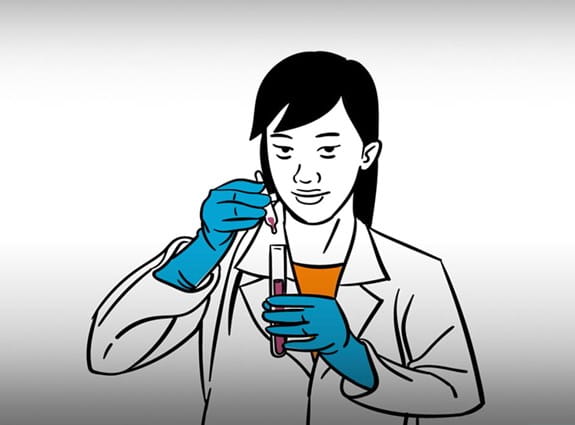What is immunotherapy?
Narrator: Immunotherapy is a treatment that helps the immune system fight cancer.
[An outline of a human body appears on screen.]
Narrator: Unlike other treatments that target cancer cells directly, immunotherapy works by boosting the immune system or helping it find and kill cancer cells.
[As the narrator speaks, a group of blue dotsrepresenting cancer appears on the chest of the body outline. Three orange concentric circles appear around the blue dots to represent a cancer treatment. The circles pulse to show that the treatment is working on the cancer cells. The circles disappear. The outline of the body changes from a solid black line to a broken orange line. The outline pulses around the blue dots to represent how immunotherapy boosts the immune system to treat cancer. The scene ends.]
Narrator: Immunotherapy works better for some cancers than others. It is a standard treatment for certain types of cancer, and it's being studied in clinical trials to see if it might be effective for many other types of cancer.
[Three doctors in lab coats are looking at a chart and talking. As the narrator speaks, the scene zooms in slightly on the doctors. Then the doctors disappear. A researcher appears. She is using a dropper to add a liquid to a test tube. The scene ends.]
Narrator: The immune system is your body's natural defence system. It's made up of organs, tissues, and cells that work together to fight off infections and diseases.
[An outline of the human body appears on screen. As the narrator speaks, parts of the immune system are shown on the body. The immune system organsinclude the spleen, thymusand tonsils.The immune system tissues include bone marrow, lymph nodes and lymph vessels. The immune system cells include lymphocytes (a type of white blood cell) and antibodies.]
Narrator: The immune system is designed to tell the difference between your own healthy cells and abnormal cells, like cancer. When immune cells find an abnormal cell in your body, the immune system responds to it, usually by removing those cells.
[We zoom in on a group of green antibodies. Three yellow lymphocytes move in among the antibodies. Both the antibodies and lymphocytes turn grey to show that they are all part of the immune system and recognize each other. Then an abnormal (blue) cancer cell appears on the right and moves closer to the other cells. All the immune system cells return to their normal colours. A group of antibodies surround and cover the cancer cell, and then those antibodies and the cancer cell disappear.]
Narrator: But the immune system doesn't always work the way it should. Some cancer cells can hide from the immune system by making themselves seem like normal cells.
[A new cancer cell moves in from the right of the screen. Two green antibodies approach it. The cancer cell grows a yellow border around it to show that it is using a disguise to hide from the immune system cells. The antibodies move away from the cancer cell.]
Narrator: And sometimes the immune system finds cancer cells, but it isn't strong enough to destroy them.
[The cancer cell turns yellow to show that it has made itself look like a normal cell. Some antibodies approach and surround the cancer cell.But they just float around the cancer cell instead of destroying it.]
Narrator: There are different types of immunotherapy drugs. Some make the immune system work harder.
[Four purple squares representing immunotherapy drugs appear from different parts of the screen and surround the antibodies around the cancer cell. All the immune system cells flash to show that the immunotherapy drugs have made them stronger.]
Narrator: Others help the immune system find cancer cells more easily.
[The immunotherapy drugs move past the antibodies to enter the cancer cell. The cancer cell turns blue again. Then the antibodies cover the cancer cell and they all disappear to show that they have killed the cancer cell. The scene ends.]
Narrator: Immunotherapy drugs are usually given through a needle in a vein. You can experience side effects from immunotherapy. Serious side effects can occur.
[A person receiving immunotherapy sits in a chair. There is an IV in his arm, which is connected to a machine and an IV bag containing immunotherapy drugs. A nurse stands next to the chair. He is making notes on a clipboard. As the narrator talks, we zoom in slightly on the person receiving immunotherapy. The scene ends.]
Narrator: But for many people, the side effects are mild. That's because immunotherapy is less likely than other cancer treatments to affect healthy cells.
[Two people ride their bikes across the screen. They are both smiling. The scene ends.]
Narrator: Everyone experiences side effects differently. To find out more about immunotherapy and if it may be an option for you, talk to your doctor.
[A person with cancer sits at a desk across from his doctor. The doctor is holding up a clipboard with information about immunotherapy. He is explaining it, and the person with cancer is listening intently. The scene ends.]
Narrator: The Canadian Cancer Society is also here to help. Visit cancer.ca or call us at 1-888-939-3333.
[The Canadian Cancer Society’s name, logo, phone number and website appear on the left of the screen. The Bank of Montreal (BMO) logo appears on the right of the screen as a proud sponsor of the Cancer Basics video series.]

